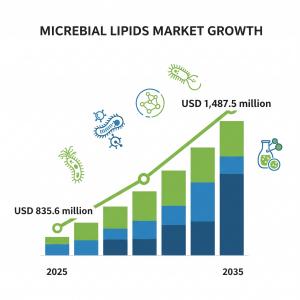Microbial Lipids Market Growth to USD 1,487.5 Million by 2035, Driven by Sustainable Bio-based Alternatives
Microbial lipids market is forecasted to grow to nearly USD 1.5 Billion by 2035 at a 5.9% CAGR, driven by sustainability and tech.
NEWARK, DE, UNITED STATES, August 19, 2025 /EINPresswire.com/ -- A new forecast report reveals a significant opportunity for manufacturers in the microbial lipids market. Projected to grow from USD 835.6 million in 2025 to USD 1,487.5 million by 2035, this market offers a compelling solution to key industry challenges like sustainability, supply chain volatility, and demand for clean-label ingredients.
This expansion represents a near 1.8x growth over the next decade, with a CAGR of 5.9%, signaling a pivotal shift toward these scalable, eco-efficient alternatives to traditional plant and animal-derived lipids.
The growth is not just a trend; it's a strategic move for manufacturers aiming to align with evolving consumer preferences and regulatory mandates. The market's early momentum (2025-2030) is fueled by the demand for yeast- and algae-derived lipids in functional foods and supplements, driven by their superior nutritional profiles and traceability. The second half of the decade (2030-2035) will see accelerated growth, powered by the scaling of synthetic biology and the integration of these lipids into high-value applications like cosmetics and biopharma.
Solving Key Manufacturing Challenges
Microbial lipids directly address the core concerns of modern manufacturers:
Sustainability and Supply Security: Traditional sources, like fish oil and palm oil, face scrutiny over environmental impact, including overfishing and deforestation. Microbial lipids offer a consistent, traceable, and environmentally friendly alternative. They can be produced year-round in controlled environments, minimizing reliance on volatile agricultural or marine supply chains.
Purity and Functionality: Produced via precision fermentation, microbial lipids offer exceptional purity and customizable lipid profiles. This is critical for applications where ingredient consistency is paramount, such as infant nutrition and pharmaceuticals. Manufacturers can now tailor specific lipid types like omega-3 fatty acids (EPA and DHA), which lead the market with a 32% share, to create products with targeted health benefits.
Innovation and Market Leadership: The rise of synthetic biology and AI-driven process control is transforming the industry. Manufacturers who invest in these technologies can optimize lipid biosynthesis for higher yields and create unique, application-specific ingredients. This not only meets consumer demand for personalized nutrition but also creates a competitive edge.
Regional Growth and Key Players
The market's expansion is not uniform, with specific regions and key players driving innovation and adoption. North America, Europe, and Asia-Pacific are the key growth regions, each leveraging unique strengths.
United States: With a projected 7.0% CAGR, the U.S. market is a powerhouse. Strong demand for vegan ingredients and significant investment in synthetic biology infrastructure are positioning American firms as global leaders. The U.S. is also a hotbed for startups leveraging "fermentation-as-a-service" models, making microbial lipid production more accessible.
United Kingdom & India: These regions follow closely with 6.8% and 6.4% CAGRs, respectively. The UK's robust biotech agenda and India's focus on functional health supplements are creating fertile ground for microbial lipid adoption.
Germany & China: Germany's focus on food safety and biotech leadership (6.1% CAGR), along with China's government-backed industrial programs (5.9% CAGR), are accelerating the integration of these ingredients into their respective manufacturing sectors.
Industry leaders like Corbion NV, DSM-Firmenich, and Cargill Inc. are maintaining their market dominance through vertical integration and regulatory expertise. At the same time, agile synthetic biology companies such as Ginkgo Bioworks and Amyris Inc. are challenging the status quo with modular production capabilities and advanced strain engineering.
Application Insights and Market Opportunities
The microbial lipids market is defined by its diverse applications, with Nutraceuticals & Dietary Supplements leading the way at 30% of the 2025 market value. This is driven by consumer interest in wellness and preventive health, where clean-label, bioavailable lipid formats enriched with omegas and phospholipids are highly sought after.
Other key application segments include:
• Functional Foods & Beverages (22%): Fortified products like dairy alternatives and energy bars are increasingly incorporating microbial lipids for their nutritional and functional benefits.
• Pharmaceuticals (15%): The high purity and consistency of microbial lipids make them ideal for drug delivery systems and medical nutrition.
• Cosmetics & Personal Care (12%): A growing demand for ethical, cruelty-free, and sustainable ingredients is fueling the use of microbial lipids in skincare and beauty products.
The market's future will be shaped by the convergence of lipid biosynthesis with precision fermentation platforms. Manufacturers who can leverage these technologies to create custom lipid profiles and embed them within circular production ecosystems will be best positioned for long-term success. The strategic shift toward these innovative ingredients is not just a commercial decision; it’s a commitment to a more sustainable, resilient, and forward-thinking future for the manufacturing industry.
Rahul Singh
Future Market Insights Inc.
+1 347-918-3531
email us here
Legal Disclaimer:
EIN Presswire provides this news content "as is" without warranty of any kind. We do not accept any responsibility or liability for the accuracy, content, images, videos, licenses, completeness, legality, or reliability of the information contained in this article. If you have any complaints or copyright issues related to this article, kindly contact the author above.

